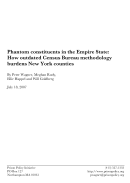
Importing Constituents:
Prisoners and Political Clout in Wisconsin
By John Hejduk and Peter Wagner
Prison Policy Initiative
March 2008
Section:
V. Methodology
This report uses the correctional facility populations as counted by the Census Bureau and published in Summary File 1, Table P37. Our analysis is based on a subset of this data, filtered to include only state or federal prisoners and not people in jail, halfway house residents, etc. Our filtering methodology is documented in Section 2 of the Democracy Toolkit (2007).[25] The Census does not publish race and ethnicity for the group quarters population at the block level, so we exported our data to Arcview 9.2, where we manually deduced the race and ethnicity of each facility’s population from tract-level data made available in tables PCT17B and PCT17H. In the few cases where this was insufficient, we accessed race and ethnicity data for the individual blocks from Tables P7 and P11, which were then attributed to the correctional facility.
As discussed in footnote 8 above, the Census placed the Federal Correctional Institution at Oxford in the wrong county. The facility’s mailing address is in Marquette County, but the prison is actually in Adams County. This mistake was corrected as a part of the Count Question Resolution program and was correctly reflected in the county level redistricting, but the correction did not arrive in time to be used in the state legislative redistricting process.
We believe that the Census Bureau double-counted the Green Bay Correctional Institution in Brown County, as the Census reported 1,936 in the facility but our historical facility population counts suggest that the figure should have been about 1,018 people. However, as this is the figure reported by the Census, and because we can identify no other population — incarcerated or otherwise — that should be attributed this population, our analysis uses the same data that the legislature did: the Census’s count of 1,936 prisoners.
Finally, the Census Bureau misclassified the Robert E. Ellsworth Correctional Center as part of the “other nonhousehold living situations” at the Southern Wisconsin Center for the Developmentally Disabled, on whose grounds the prison sits. Because this was a correctional population counted in the Census and this data was used to draw legislative districts, our analysis counted this population as a correctional population. However, this classification mistake made it impossible to deduce the race and ethnicity of the people incarcerated at the Robert E. Ellsworth Correctional Center, so we used the counts taken on June 30 2000, by the Bureau of Justice Statistics, Census of State and Federal Correctional Facilities, 2000: 251 people incarcerated, of which 90 were Black and 70 were Latino.
The impact on individual state districts and counties was calculated in ArcView 9.2 based on shapefiles distributed by the Census Bureau and the Wisconsin Legislative Redistricting Information website.
Our analysis of the impact on county districts follows the methodology in the Democracy Toolkit to determine whether prison populations were excluded from districts and to calculate the resulting vote dilution in counties that included them. Most counties told us that they felt obligated to include the prison populations in the districts, and we set out to calculate the impact on their democracy that resulted. Most counties did not publish the population totals for their districts, so we calculated the population totals by overlaying Census data over the county district maps in Arcview. In the counties that publish electronic files with the shapes of their districts, this calculation was straightforward. In other counties, we recreated their paper maps in Arcview and then calculated the population totals using both official Census data and a special version of the Census data with the prison populations removed. In all cases, the total population (including the prison population) in each district was approximately the ideal district size for that county, confirming that the districts were indeed based on prison populations.
The incarceration rates for counties, published in Appendix D, were calculated from Professor Pamela Oliver’s Excel spreadsheets for Wisconsin county imprisonment rates data [XLS], and the official Census 2000 population counts for counties, to represent the rates at which county residents are sent to prison. (Federal and local jail imprisonment would therefore be excluded from these relative comparisons.)
Footnotes
[25] Peter Wagner, Democracy Toolkit, Prison Policy Initiative (2007).
Events
- April 15-17, 2025:
Sarah Staudt, our Director of Policy and Advocacy, will be attending the MacArthur Safety and Justice Challenge Network Meeting from April 15-17 in Chicago. Drop her a line if you’d like to meet up!
Not near you?
Invite us to your city, college or organization.



